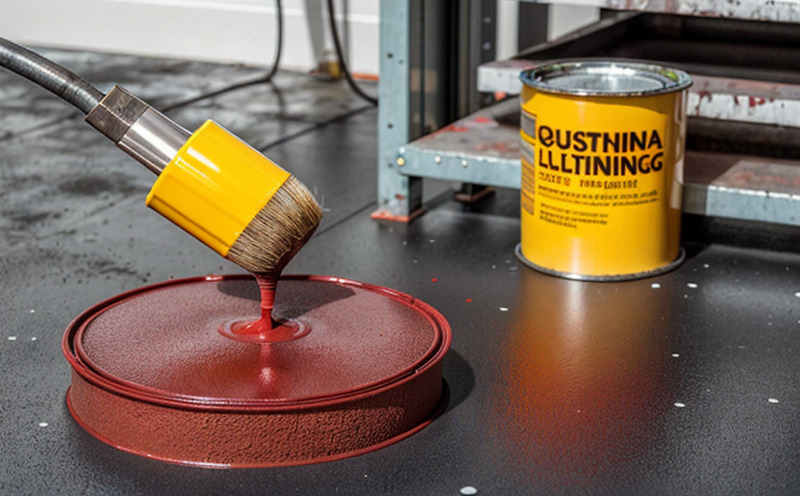ISO 20358 Fire Resistance Testing of Coatings
The ISO 20358 fire resistance testing method is a critical standard designed to evaluate the performance of coatings in high-temperature environments. This test is particularly important for industrial manufacturing and processing, where protective coatings are used on surfaces that may come into contact with flames or other sources of heat during manufacturing processes. The primary purpose of this testing is to assess whether the applied coating can resist ignition, flame spread, and penetration by fire.
The standard applies specifically to coatings intended for use in environments exposed to fire hazards, such as those used on structural components, machinery parts, and safety equipment within industrial settings. By ensuring compliance with ISO 20358, manufacturers and processors can guarantee that their products meet the necessary safety standards, thereby protecting workers and assets from potential fire risks.
The testing process involves subjecting coated specimens to controlled burns in a furnace. The duration of exposure depends on the specific requirements set forth by the standard, but generally ranges between 15 minutes and up to several hours. During this time, various parameters are monitored including flame propagation rate, mass loss, and residual integrity of the coating after exposure.
For accurate results, it is crucial that proper sample preparation be conducted prior to testing. This includes cleaning the test specimen according to ISO 20358 guidelines, applying the specified type and amount of coating, allowing sufficient curing time, and ensuring uniformity across all samples being tested. Once prepared, specimens are loaded into a specially designed furnace where they undergo controlled heating at predetermined temperatures.
The equipment used for performing this test includes furnaces capable of maintaining stable temperatures within narrow ranges while also providing precise control over the rate of temperature rise. Additionally, automated systems may be employed to measure key performance indicators such as mass change and structural integrity throughout the duration of the test cycle.
In order to ensure reliable data collection during testing, adherence to strict protocol is essential. This includes maintaining consistent environmental conditions prior to and during the experiment, using calibrated instrumentation for accurate measurements, and employing trained personnel who are familiar with both the equipment being used as well as best practices associated with ISO 20358 compliance.
Compliance with this standard not only ensures product safety but also demonstrates a commitment to quality control which can enhance customer confidence and potentially lead to increased market share. Furthermore, successful completion of these tests can open doors for international trade by meeting the requirements set forth by various regulatory bodies around the world.
Scope and Methodology
| Key Parameters | Description |
|---|---|
| Furnace Temperature Range | The temperature must be controlled precisely within the specified limits, typically between 50°C and 1000°C. |
| Specimen Size | Standardized dimensions ensure consistency across all samples being tested. Dimensions vary based on the specific application but are usually around 250 mm x 250 mm x 10 mm thick. |
| Test Duration | Durations range from 15 minutes to several hours depending upon the material properties and end-use requirements of the coating being evaluated. |
| Data Collection | Automated systems measure key performance indicators such as mass change, structural integrity, and flame propagation rates during testing. |
The methodology outlined in ISO 20358 provides clear instructions on how to prepare specimens, operate the furnace, monitor critical parameters throughout each test cycle, and interpret results based on predefined criteria. Compliance with these procedures ensures accurate evaluation of a coating’s fire resistance properties under controlled conditions.
Environmental and Sustainability Contributions
The implementation of ISO 20358 fire resistance testing contributes positively to environmental sustainability efforts by promoting the use of safer materials in industrial applications. By ensuring that coatings used within manufacturing processes meet stringent safety standards, companies can reduce risks associated with flammable substances being exposed directly to heat sources.
Additionally, adherence to this standard encourages innovation and development of new technologies aimed at improving product performance while minimizing environmental impact. For instance, manufacturers may explore alternative raw materials or production methods that offer enhanced resistance without compromising on quality or efficacy.
Incorporating ISO 20358 into industrial practices helps foster a culture focused on continuous improvement and best practice implementation across all stages of the supply chain. This approach leads to greater efficiency in resource utilization, reduced waste generation, and overall lower carbon footprints for businesses operating within this sector.
Competitive Advantage and Market Impact
- Ensures consistent quality control through rigorous testing procedures.
- Demonstrates commitment to safety standards which enhances customer confidence.
- Promotes innovation by encouraging exploration of safer materials and production methods.
- Facilitates compliance with international regulations, thereby opening up new markets for exporters.
- Improves reputation among stakeholders including employees, investors, and regulatory bodies.
By incorporating ISO 20358 into their testing protocols, companies in the industrial coatings sector gain a competitive edge that sets them apart from competitors who do not prioritize safety and quality assurance. This can translate into increased sales volumes, improved brand loyalty, and greater long-term profitability for organizations adopting this standard.





